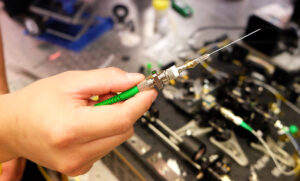Concerned farmers formed the Oyster Harbour Catchment Group (OHCG) in 1992.
The catchment covers about 3,000km2 between Tenterden and Albany.
It includes the Stirling Range and Porongurup National Parks, Kalgan and King river systems and Oyster Harbour.
In total, there are approximately 31 Nature Reserves and 38 listed Heritage Sites within the catchment.
HARBOUR IN NEED OF A HELPING HAND
OHCG chairwoman Heather Adams says the harbour’s degraded condition was the catalyst.
“We’d lost all the seagrass in the harbour and…a lot of the marine ecosystem that depended on that seagrass to live,” she says.
Nitrogen and phosphorus fertilisers washing into waterways was contributing to the problem.
A ‘WONDERFUL SUCCESS STORY’
The OHCG has received more than $4.5 million in State and Commonwealth funding for 50 projects over the past seven years.
Activities include fencing waterways and remnant vegetation to keep livestock out, planting native trees and controlling invasive weeds.
They work with other community conservation groups, local government and government agencies to promote the importance of natural resource management.
Heather’s highlight over 23 years is Oyster Harbour’s restoration.
“It’s been an outstanding success,” she says.
“Oyster Harbour is one of the few places in the world where a harbour has been reclaimed.”
“We’ve been able to establish seagrass beds very successfully…which I don’t think has been achieved to the same degree anywhere else in the world.”

PERSISTENCE PAYS OFF
Heather credits the group’s positive contribution to the catchment’s health to persistence.
“There’s a lot of very dedicated people…who are passionate about caring for the environment,” she says.
“I’m constantly astounded by the commitment and the passion other people have.”
“The local farmers and even the smaller landholders are quite remarkable.”
“They all want to do the best they can to look after the land.”

PROTECTING PLANT AND ANIMAL BIODIVERSITY
Living in an internationally renowned biodiversity hotspot motivates the group’s members.
“We live in one of the most amazingly diverse places in the world as far as animals and particularly plants go,” Heather says.
“A lot of people understand how lucky we are… and they really value that.”
“It’s not hard to keep enthused about what we do when you’re protecting and enhancing some remarkable areas of flora.”
“Once we protect and enhance those areas, we can provide and protect the habitat the animals need.”
NEW MEMBERS WELCOME
The OHCG has 50-60 members, which have grown to include small landholders, former scientists and natural resource management specialists, community members and other stakeholders.
Heather says there’s always room for more.
“I think we could quite happily work for another 30 years and still be doing similar activities to what we’re doing now,” she says.
Want to get involved? Visit the OHCG website to get in touch.








